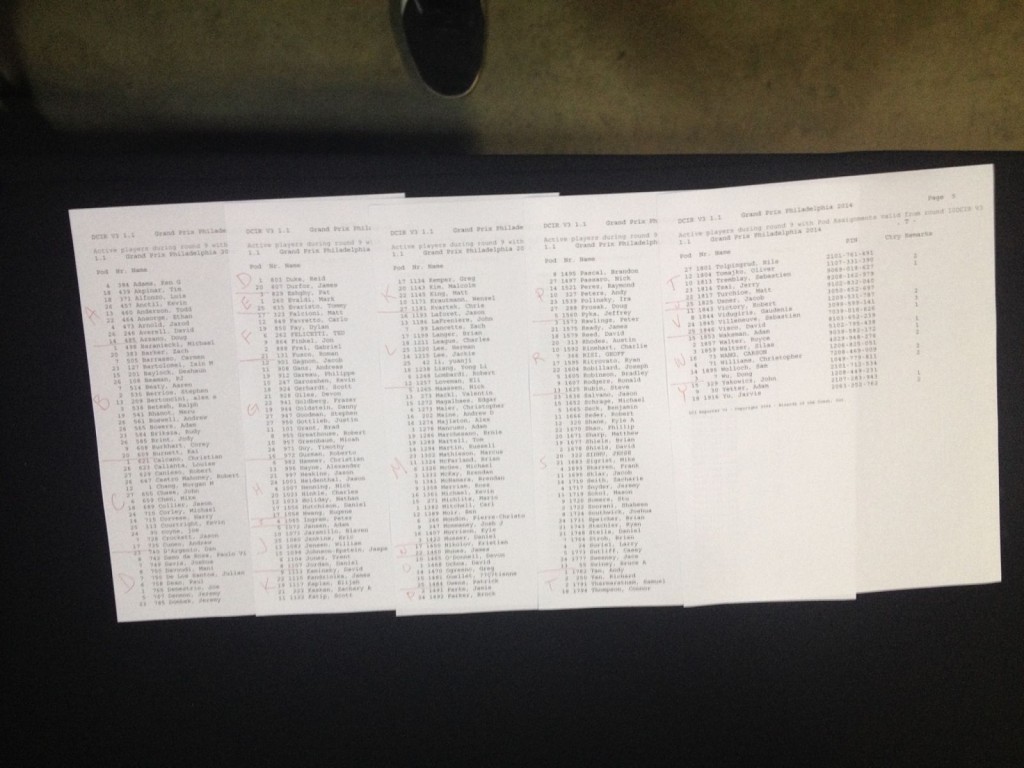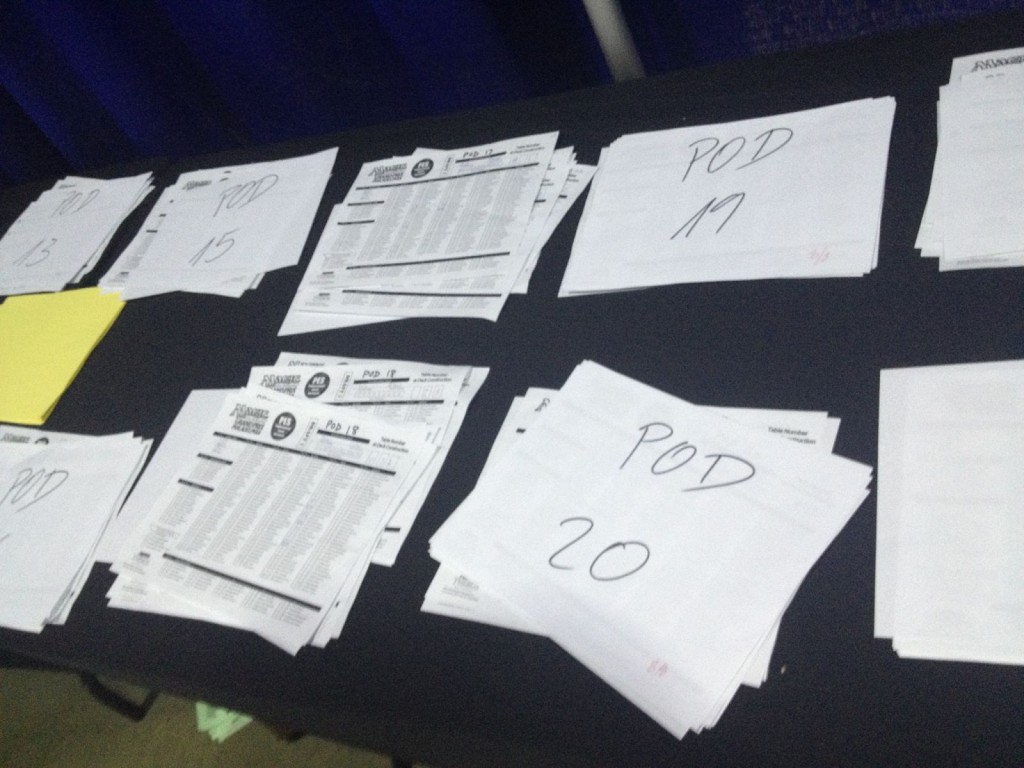In this article, I’d like to present an alternate way to sort decklists in tournaments involving pods – especially limited Grand Prix day two and Pro Tours. The method works off the well-recognized idea that sorting by numbers is much easier (and less error-prone) than doing so by name. This article presents the procedure including all the refinements discovered so far (with examples of ideas tried and failed). A big thank you to all the judges that have helped me try this method at Pro Tours Theros & Born of the Gods, but especially Damian Hiller, Kim Warren
, David de la Iglesia
, and Riccardo Tessitori
.
- Sorting is fairly quick, because we use numbers (up to 50), and doesn’t use up much space
- It is easy to spot check, if all the decklists are present – we check if each pod has 8 (or 7) decklists
- Decklists are automatically divided into piles that are easy to assign for counting and better randomized than using players’ names
- Pulling decklists (coverage, deck checks) is much faster, since each pair of decklists will be in the same pile (pod)
The Pledge
To get this method to work, some setup is needed. However, it’s not much more than for any “traditional” method. You will need the following (mostly from the Scorekeeper):
- Players by Name with pod number (i.e. what is posted on the Pairing boards)- when possible, tape this list to the wall behind the deck check station.
- Players by Pod (i.e. what is cut up and laid out on the draft tables)
- Sheets of paper with number ranges of 12 (1-12, 13-24, …) up to the top pod number. If you have a low number of pods, you can split these into piles of 6 (1-6, 7-12, …)
- Decklists with the pod number pre-printed on them plus a number of blank spares. If pre-printing is not possible, you can prepare these by hand.
Reason: About half of the players will not remember their pod number or write down something else like their current table number. Fixing the written down pod number takes time and effort. Having the pod number in a specific place on the decklist makes sorting easier.
Get the Players by Name and Player by Pod print outs only once the draft has started.

Reason: The scorekeeper should have more time. Also, late entries may mean changes to several bottom pods.
Set up the deck check table by spreading out the number ranges. This is where you will sort.
The Turn
The sorting is pretty straightforward – just put the decklist on the correct pile based on the pod range (Pods 1-12, 13-24, etc.). At the end of this you will have 4-5 piles of about 100 decklists (or 50, if using the smaller ranges). All this time, have one judge ready to handle decklists missing a pod number or with an incorrect one (i.e. one with a number higher than the top pod).
Now each judge grabs a pile of decklists and does a second pass, sorting the decklists into their specific pods. At the end of this, you should have a pile for each pod with 8 (or 7) decklists each. Now check off the names against the list of players by pod. Start with the ones that have an incorrect number of decklists, so you can deck check in the first round of the drafts). Don’t bother to alphabetize inside the pod. [Note: if each pile has the correct number of decklists, you’re nearly sure to have all the decklists].

Reason: Sorting into a bucket then sorting each bucket in turn is faster and provides a better way to sort in parallel. Once you have piles of 8, there is no benefit to sorting by name, since you only need to look at eight decklists to find a specific one. I recommend sorting into groups of 12, because that’s the way the players by pod printings come, which means you won’t have to “share” with another judge.
The Prestige
Now that we have the decklists sorted, we have a couple of advantages:
- When pulling decklists for a deck check or feature match, we need to check the pod number of one of the players and search a pile of eight for the specific decklists
- When coverage asks for all the decklists from a pod, we simply hand over a whole prepared pile
- When counting decklists, they’re already organized in semi-random* order; also eight decklists are pretty fast to count and less error prone, so a spare judge can quickly do one pod, mark it as done, and move to other tasks.
Reason: It is faster to look up one name in an alphabetical (printed) list to get the pod number and then choose two names from a pile of eight decklists, than it is to look through a binder, which becomes unordered as the decklists get swapped in and out. If coverage knows the pod number they’re featuring, we actually skip the first step. There’s also no contention over access to the binder.
Thank You Ladies and Gentleman!
I, and others who’ve tried this, have found this method to be efficient and effective in assuring that all decklists are present and have them available. Once we got the kinks out of the system, we were able to sort everything, to hand decklists to coverage with no wait time, and to sort everything before the end of the first round.
